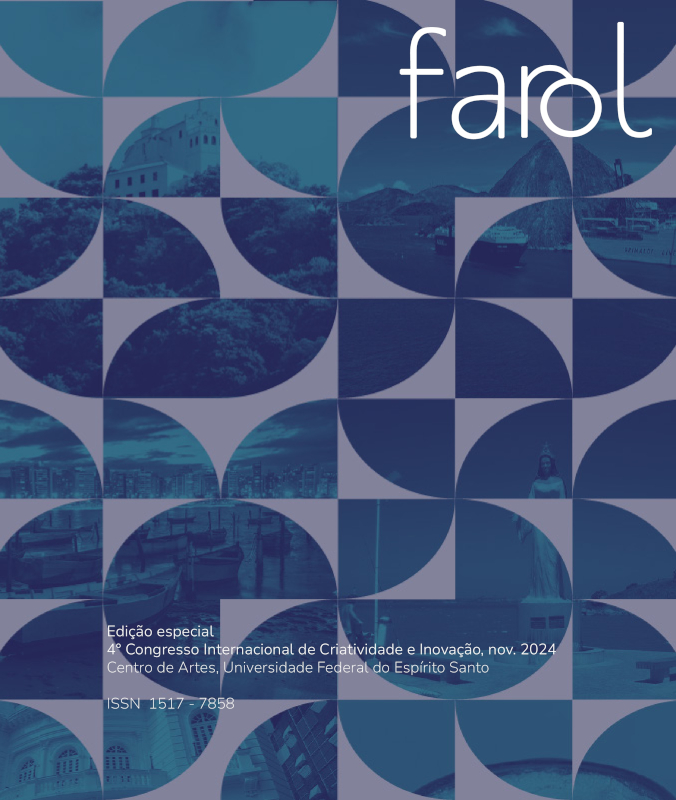Creativity and Innovation 4.0. Promoting Renewal through Possibility Thinking
Keywords:
criatividade, inovação, pensamento de possibilidadesAbstract
This article explores the connections between creativity, innovation, and modern citizenship, focusing on “Creativity and Innovation 4.0” to understand how these dimensions contribute to technological advances and reshape social norms. The paper also addresses the challenges and limitations of possibility thinking, including technological inequalities. Finally, the article outlines a path toward a society in which creativity and innovation serve not only economic development but also the enrichment of democratic life.
Downloads
References
APPADURAI, A. The Future as Cultural Fact: Essays on the Global Condition. Rassegna Italiana di Sociologia, Rivista Trimestrale Fondata da Camillo Pellizzi, 2013.
BAKHTIN, M. M. Problems of Dostoevsky's Poetics. Edited and translated by Caryl Emerson. University of Minnesota Press, 1984.
BARBOT, B.; KAUFMAN, J. C. What makes immersive virtual reality the ultimate empathy machine? Computers in Human Behavior, v. 111, Article 106431, 2020.
BEGHETTO, R. A.; GLĂVEANU, V. P. The beautiful risk of moving toward pedagogies of the possible. In: The Palgrave Handbook of Transformational Giftedness for Education. Springer, 2022. p. 23-42.
BRUCE, D. D.; CROOK, G. The Dream Cafe: Lessons in the Art of Radical Innovation. Wiley, 2015.
CHRISTENSEN, C. M.; RAYNOR, M. E. The Innovator’s Solution: Creating and Sustaining Successful Growth. Harvard Business School Press, 2003.
CRAFT, A. Possibility thinking: From what is to what might be. In: WEGERIF, R.; LI, L.; KAUFMAN, J. C. (Eds.). The Routledge International Handbook of Research on Teaching Thinking. Routledge, 2015. p. 177-191.
EPSTEIN, J. L. School, Family, and Community Partnerships: Preparing Educators and Improving Schools (2nd ed.). Routledge, 2011. https://doi.org/10.4324/9780429494673
GLĂVEANU, V. P. The Possible: A Sociocultural Theory. Oxford University Press, 2020.
GLĂVEANU, V. P.; KARWOWSKI, M.; ROSS, W.; BEGHETTO, R. A. Possibility thinking scale: An initial psychometric exploration. Possibility Studies & Society, v. 2, n. 1, p. 125-147, 2024.
GLĂVEANU, V. P.; NESS, I. J.; WASSON, B.; LUBART, T. Sociocultural perspectives on creativity, learning, and technology. In: MULLEN, C. A. (Ed.). Creativity Under Duress in Education?. Springer, Cham, Switzerland, 2019. p. 63-82.
HUGHES, D. J.; LEE, A.; TIAN, A. W.; NEWMAN, A.; LEGOOD, A. Leadership, creativity, and innovation: A critical review and practical recommendations. The Leadership Quarterly, 2018.
LUBART, T. The 7 C's of creativity. The Journal of Creative Behavior, v. 51, n. 4, p. 293-296, 2017.
MANGION, M.; VALQUARESMA, A. Calling out for the possible! Is it our chance to make it right? Creativity: Theories – Research – Applications, 2024.
MULGAN, G. The process of social innovation. Innovations: Technology, Governance, Globalization, v. 1, n. 2, p. 145-162, 2006.
OECD. The OECD Learning Compass 2030. OECD Publishing, 2020.
OECD. The Culture Fix: Creative People, Places and Industries. Local Economic and Employment Development (LEED), OECD Publishing, Paris, 2022. https://doi.org/10.1787/991bb520-en
OECD. PISA 2022 Results (Volume III): Creative Minds, Creative Schools. OECD Publishing, Paris, 2024. https://doi.org/10.1787/765ee8c2-en
RHODES, M. An analysis of creativity. The Phi Delta Kappan, v. 42, n. 7, p. 305-310, 1961. http://www.jstor.org/stable/20342603
SATALKINA, L.; STEINER, G. Social innovation: A retrospective perspective. Minerva, v. 60, p. 567-591, 2022. https://doi.org/10.1007/s11024-022-09471-y
SUSSKIND, R.; SUSSKIND, D. The Future of the Professions: How Technology Will Transform the Work of Human Experts. Oxford University Press, UK, 2015.
TAPSCOTT, D.; WILLIAMS, A. D. Wikinomics: How Mass Collaboration Changes Everything. Portfolio, New York, 2006.
WIEDEMER, D.; WIEDEMER, R. A.; SPITZER, C. S. Aftershock: Protect Yourself and Profit in the Next Global Financial Meltdown. John Wiley & Sons, 2015.
WILKIE, A.; SAVRANSKY, M.; ROSENGARTEN, M. (Eds.). Speculative Research: The Lure of Possible Futures. 1st ed. Routledge, 2017. https://doi.org/10.4324/9781315541860
WOLFF, J. How is technology changing the world, and how should the world change technology? Global Perspectives, v. 2, n. 1, p. 27353, 2021.
Downloads
Published
How to Cite
Issue
Section
License
Copyright (c) 2024 Margaret Mangion

This work is licensed under a Creative Commons Attribution-NonCommercial-ShareAlike 4.0 International License.
The authors of works submitted to Revista Farol authorize their publication in physical and electronic media, solely for academic purposes, and may be reproduced as long as the source is cited. They attest to their originality, authorship and originality.





